Starting a My Body theme with your kids at home or school? Here are some fun body parts activities for preschoolers.
They are all play-based ideas that incorporate:
- creative art
- music and movement
- stories, discussions and dramatic play
- science, maths and cooking
There’s also a printable of these activities at the end of this post.
1. Body Tracing
First, have the kids lie down on large sheets of paper while an adult traces around their bodies.
After that, let them have fun decorating their outlines. Depending on their age and what they’re learning, they can add their names, draw in details, and label different body parts
2. Hand and Foot Painting
When the weather’s nice, take this activity outside. Paint the bottoms of the kids’ feet and the palms of their hands with washable paint.
Have them press their feet or hands onto big sheets of paper to create colourful prints. Just be sure to have lots of soapy water ready for cleanup!
3. Bone Painting with Cotton Swabs
Show the kids a few examples of X-rays to get them inspired. Give them cutouts of the human body on dark construction paper (or let them trace and cut out their own).
Then, they can dip cotton buds into white tempera paint and create “bones” on their cutouts.
4. Fingerprinting Fun
Set out some washable coloured ink pads and plain paper, and encourage children to get creative.
They can press their fingerprints onto the paper and then use pencils or markers to turn those prints into fun pictures.
5. Modeling with Playdough
Get the kids to craft some fun 3-D body figures. Show them how to roll pieces of dough to create limbs or shape a round ball for the head.
They can also make larger, flatter face models, adding on the right features as they go.
And here’s a simple recipe for playdough that doesn’t require cream of tartar.
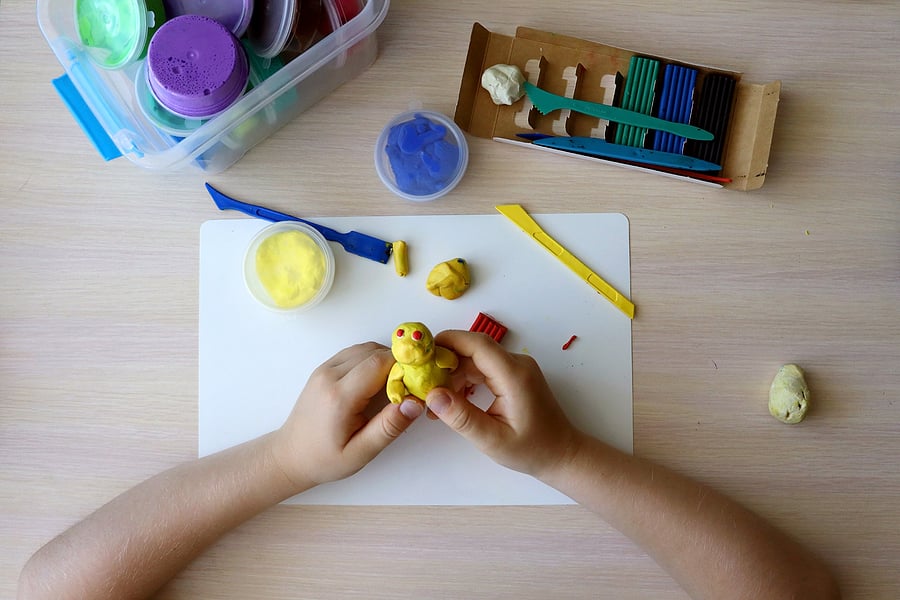
6. Playing and Singing Old Favorites
These songs teach the body parts as well as movements that the body makes:
- Hokey Pokey
- Head, Shoulders, Knees and Toes
- If You’re Happy and You Know It
- Shake Your Sillies Out
- Open, Shut Them
- Simon Says
- Where is Thumbkin?
- Scrub a Dub Dub Song
7. Moving to the Beat
Play clips of different music styles and challenge the kids to dance in a way that matches the speed and mood of each tune—all while making sure they don’t bump into any of the other dancers!
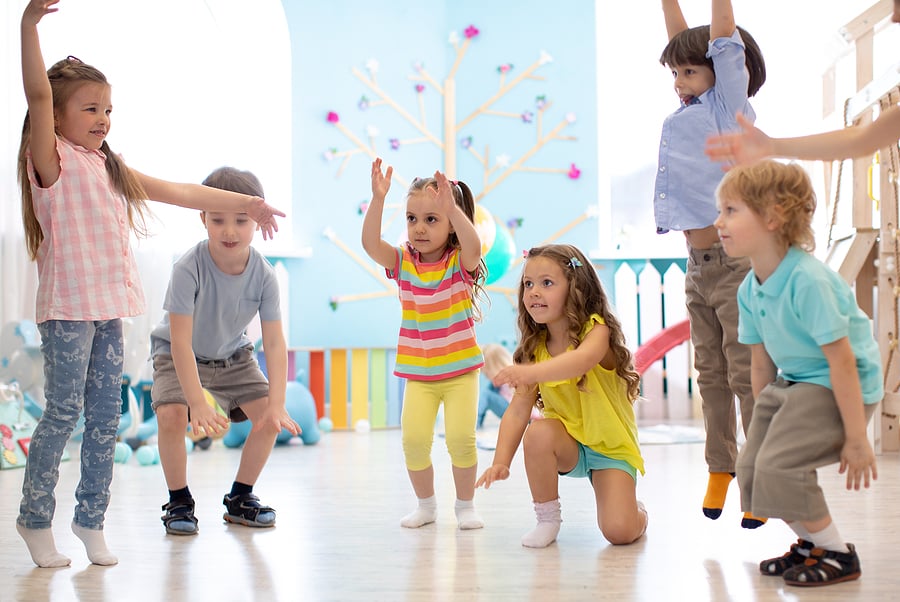
8. Moving Like Animals
Look at pictures of and discuss various types of animals.
- How would they move their heads?
- How would they walk and prance?
- What sounds could come from their mouths?
Encourage children to move and behave like the animals of the forest, farm, or jungle.
9. Body Balancing
Show the children how to walk along a “balance beam” made from a rope or a strip of masking tape on the floor.
For an extra challenge, have them try walking with a beanbag in different positions—like on their head, in their hands, tucked into the crook of an elbow, or even under their chin.
10. Sharing Books and Videos
Tons of books in print and other media can be found at the library and online. Here are just a few popular titles that fit with the human body theme:
I’m Growing – by Aliki
Me and My Amazing Body – Joan Sweeney
From Head to Toe – Eric Carle
11. Writing and Illustrating a Class Book
After reading several books about bodies, invite the children to help create a class book inspired by a popular title.
They can dictate the story while you write it down on large chart paper, leaving space for illustrations. Once the writing is done, the kids can add their drawings to the pages.
When the book is complete, gather everyone to read it together.

12. Acting Out Literature
After reading and discussing fictional stories that fit with the body parts theme, invite preschoolers to act out the stories, using puppets, costumes and props.
Here are four types of puppets that are easy to make.
13. Playing Hospital
Set out some simple props or real tools and supplies that doctors and nurses use, and encourage the kids to dive into some dramatic play.
Be sure to include paper, pencils and supplies for the “office work” that often comes with playing in this setting.
14. Exploring Body Symmetry
Fold or draw a vertical line down the centre of some cut-outs of body shapes.
Discuss how both sides of the body have one of each facial feature or limb – except certain features – and how each hand or foot has five fingers or toes.
A great book to use with this topic is Seeing Symmetry by Loreen Leedy.
15. Counting Bones
Put together, our two feet contain 52 bones! Show what 52 of something looks like in materials such as small building blocks or dominoes.
Practise counting up to 52 together. Share The Foot Book by Dr. Seuss.
16. Digesting Stomachs
Offer small sealable plastic bags and a variety of foods that are easily smashed, smushed and mushed.
Children choose the foods for their plastic “stomachs,” seal them closed and apply pressure with their hands to show what happens to foods when they are digested.
17. Measuring with Non-Standard Units
Kids can measure things around the room without tape measures or rulers. Encourage them to use their own feet to measure and compare distances or lengths of various large objects.
They can list these, by drawing pictures of the items on paper and noting the number of how many “feet” long they each measure.
18. Sorting Body Parts
Have the children cut or tear out pictures of different body parts from magazines.
They can then glue these pictures into pre-labeled categories like heads, arms, hands, legs, and feet on a large sheet of paper to create a collage.
19. Designing Fruit and Veggie Faces
Give the kids a base like toasted bread, warm tortillas, or English muffins, and let them spread on their choice of cream cheese or peanut/plant butter.
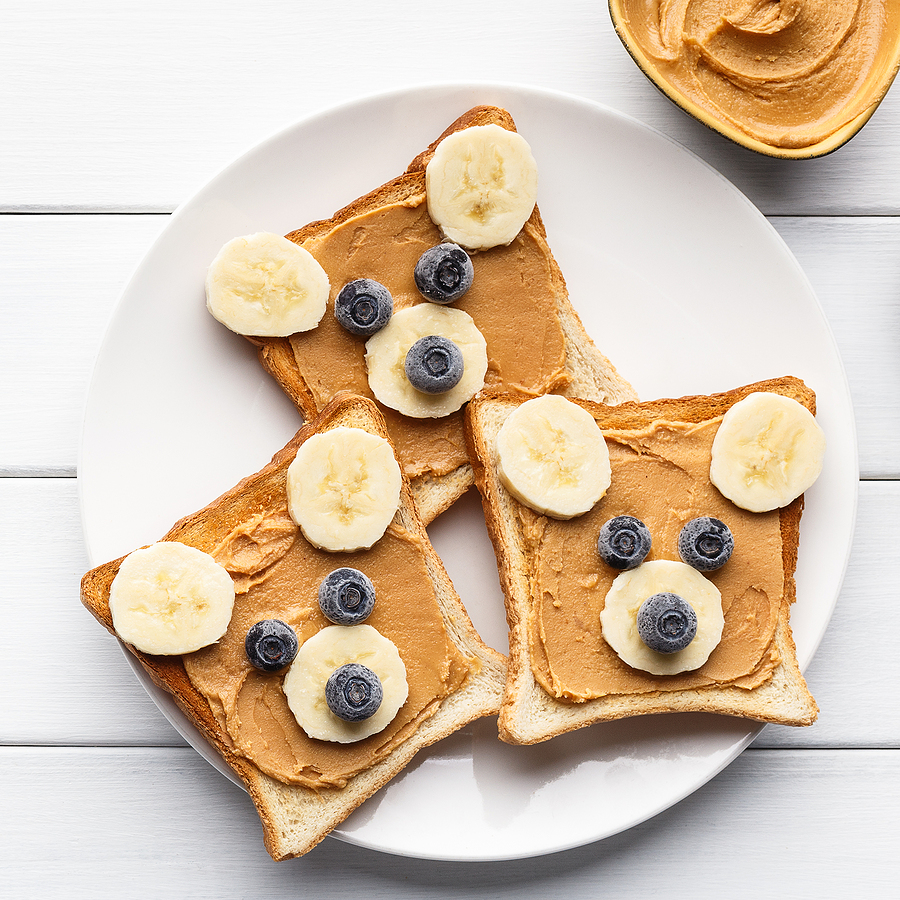
Then, offer a variety of healthy foods—like raisins, carrot or banana slices, and apple pieces—that they can use to create fun facial features.
20. Cutting and Spreading
As the kids prepare simple snacks like cracker “sandwiches,” they’ll practice controlling their fingers, hands, and arms by using safe tools to cut and spread different food items.
21. Taking Heartbeat Breaks
During free play, take a few breaks to have the children feel their chests and notice how their heartbeats are faster compared to when they’re at rest.
22. Spontaneous Exercising
While playing outside, children exercise and become even more aware of their bodies by running, jumping, crawling, skipping and climbing.
I hope you’ve enjoyed these ideas for teaching body parts to preschoolers. As you can see, body theme activities can be carefully planned or spontaneous.
Pick and choose as you wish, even incorporating challenges into cleanup time: “lift the blocks using only your thumbs and pointer fingers” or “bulldoze the blocks toward the corner using only your feet!”
The opportunities for learning are endless.
Here are more preschool themes if you need some fresh ideas.
The 22 Most Fun Body Parts Activities for Preschoolers
Notes
Starting a My Body theme with your kids at home or school? Here are some fun body parts activities for preschoolers.
They are all play-based ideas that incorporate:
creative art
music and movement
stories, discussions and dramatic play
science, maths and cooking
1. Body Tracing
First, have the kids lie down on large sheets of paper while an adult traces around their bodies.
After that, let them have fun decorating their outlines. Depending on their age and what they’re learning, they can add their names, draw in details, and label different body parts
2. Hand and Foot Painting
When the weather’s nice, take this activity outside. Paint the bottoms of the kids’ feet and the palms of their hands with washable paint.
Have them press their feet or hands onto big sheets of paper to create colourful prints. Just be sure to have lots of soapy water ready for cleanup!
3. Bone Painting with Cotton Swabs
Show the kids a few examples of X-rays to get them inspired. Give them cutouts of the human body on dark construction paper (or let them trace and cut out their own).
Then, they can dip cotton buds into white tempera paint and create “bones” on their cutouts.
4. Fingerprinting Fun
Set out some washable coloured ink pads and plain paper, and encourage children to get creative.
They can press their fingerprints onto the paper and then use pencils or markers to turn those prints into fun pictures.
5. Modeling with Playdough
Get the kids to craft some fun 3-D body figures. Show them how to roll pieces of dough to create limbs or shape a round ball for the head.
They can also make larger, flatter face models, adding on the right features as they go.
And here's a simple recipe for playdough that doesn't require cream of tartar.
6. Playing and Singing Old Favorites
These songs teach the body parts as well as movements that the body makes:
Hokey Pokey
Head, Shoulders, Knees and Toes
If You’re Happy and You Know It
Shake Your Sillies Out
Open, Shut Them
Simon Says
Where is Thumbkin?
Scrub a Dub Dub Song
7. Moving to the Beat
Play clips of different music styles and challenge the kids to dance in a way that matches the speed and mood of each tune—all while making sure they don’t bump into any of the other dancers!
8. Moving Like Animals
Look at pictures of and discuss various types of animals.
How would they move their heads?
How would they walk and prance?
What sounds could come from their mouths?
Encourage children to move and behave like the animals of the forest, farm, or jungle.
9. Body Balancing
Show the children how to walk along a “balance beam” made from a rope or a strip of masking tape on the floor.
For an extra challenge, have them try walking with a beanbag in different positions—like on their head, in their hands, tucked into the crook of an elbow, or even under their chin.
10. Sharing Books and Videos
Tons of books in print and other media can be found at the library and online. Here are just a few popular titles that fit with the human body theme:
I’m Growing – by Aliki
https://www.youtube.com/watch?v=EEOHX6d3aCA
Me and My Amazing Body – Joan Sweeney
https://www.youtube.com/watch?v=JEbRZqwmwI8
From Head to Toe – Eric Carle
https://www.youtube.com/watch?v=fOIx72g0UdA
11. Writing and Illustrating a Class Book
After reading several books about bodies, invite the children to help create a class book inspired by a popular title.
They can dictate the story while you write it down on large chart paper, leaving space for illustrations. Once the writing is done, the kids can add their drawings to the pages.
When the book is complete, gather everyone to read it together.
12. Acting Out Literature
After reading and discussing fictional stories that fit with the body parts theme, invite preschoolers to act out the stories, using puppets, costumes and props.
Here are four types of puppets that are easy to make.
13. Playing Hospital
Set out some simple props or real tools and supplies that doctors and nurses use, and encourage the kids to dive into some dramatic play.
Be sure to include paper, pencils and supplies for the "office work" that often comes with playing in this setting.
14. Exploring Body Symmetry
Fold or draw a vertical line down the centre of some cut-outs of body shapes.
Discuss how both sides of the body have one of each facial feature or limb - except certain features - and how each hand or foot has five fingers or toes.
A great book to use with this topic is Seeing Symmetry by Loreen Leedy.
https://www.youtube.com/watch?v=GL0Cvu_7pKY
15. Counting Bones
Put together, our two feet contain 52 bones! Show what 52 of something looks like in materials such as small building blocks or dominoes.
Practise counting up to 52 together. Share The Foot Book by Dr. Seuss.
https://www.youtube.com/watch?v=_T0WVsukhXM
16. Digesting Stomachs
Offer small sealable plastic bags and a variety of foods that are easily smashed, smushed and mushed.
Children choose the foods for their plastic “stomachs,” seal them closed and apply pressure with their hands to show what happens to foods when they are digested.
17. Measuring with Non-Standard Units
Kids can measure things around the room without tape measures or rulers. Encourage them to use their own feet to measure and compare distances or lengths of various large objects.
They can list these, by drawing pictures of the items on paper and noting the number of how many “feet” long they each measure.
18. Sorting Body Parts
Have the children cut or tear out pictures of different body parts from magazines.
They can then glue these pictures into pre-labeled categories like heads, arms, hands, legs, and feet on a large sheet of paper to create a collage.
19. Designing Fruit and Veggie Faces
Give the kids a base like toasted bread, warm tortillas, or English muffins, and let them spread on their choice of cream cheese or peanut/plant butter.
Then, offer a variety of healthy foods—like raisins, carrot or banana slices, and apple pieces—that they can use to create fun facial features.
20. Cutting and Spreading
As the kids prepare simple snacks like cracker "sandwiches," they’ll practice controlling their fingers, hands, and arms by using safe tools to cut and spread different food items.
21. Taking Heartbeat Breaks
During free play, take a few breaks to have the children feel their chests and notice how their heartbeats are faster compared to when they’re at rest.
22. Spontaneous Exercising
While playing outside, children exercise and become even more aware of their bodies by running, jumping, crawling, skipping and climbing.
I hope you've enjoyed these ideas for teaching body parts to preschoolers. As you can see, body theme activities can be carefully planned or spontaneous.
Pick and choose as you wish, even incorporating challenges into cleanup time: “lift the blocks using only your thumbs and pointer fingers” or “bulldoze the blocks toward the corner using only your feet!”
The opportunities for learning are endless.
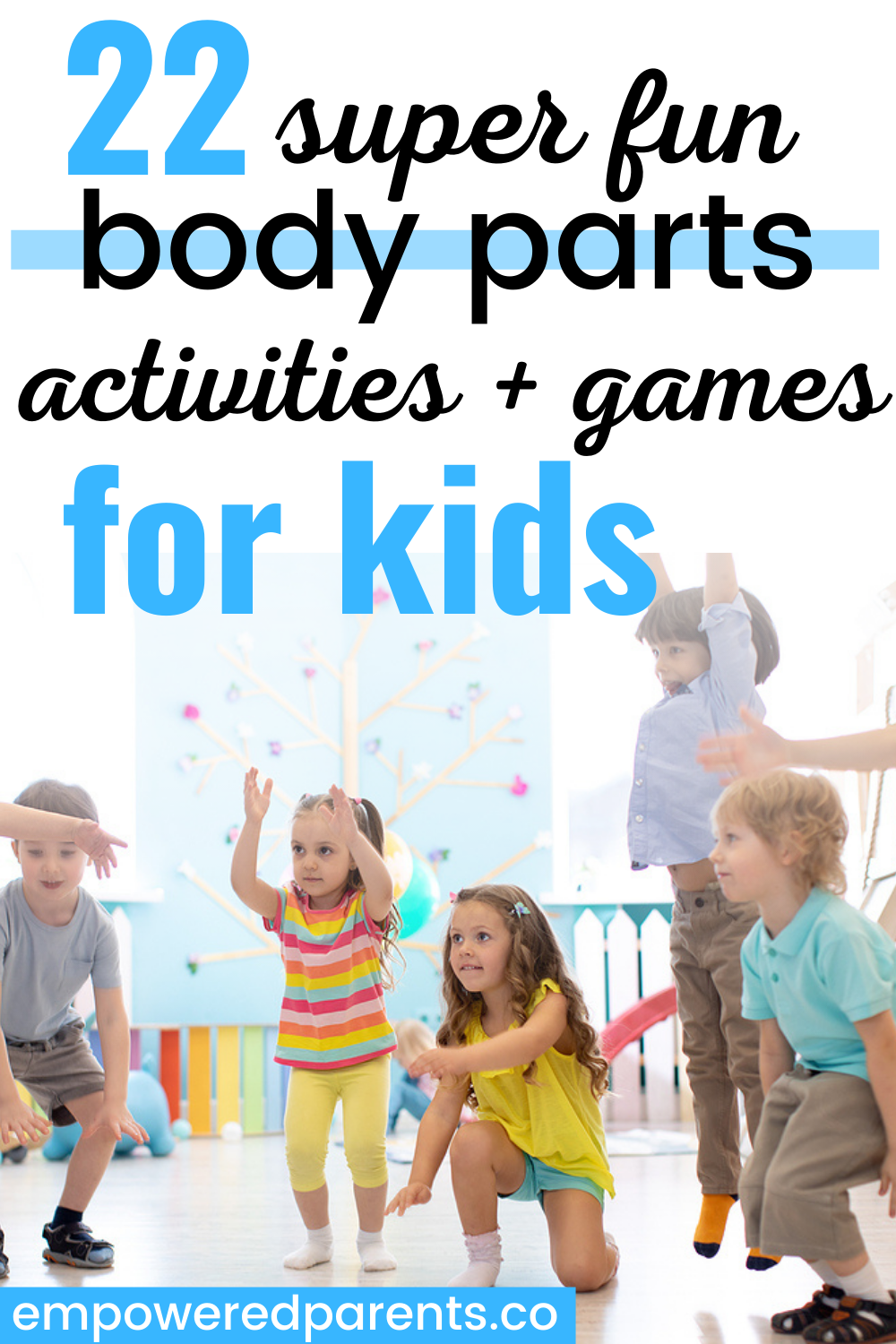
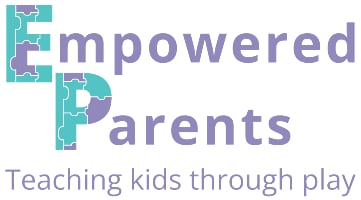
kay
Saturday 25th of November 2023
very creative work, thank you for sharing
Ikechukwu Faith.
Wednesday 9th of August 2023
I love it! It's so amazing.
Tanja Mcilroy
Thursday 17th of August 2023
I'm glad to hear it!
farrell
Thursday 18th of May 2023
I love the learning
Tanja Mcilroy
Friday 19th of May 2023
I'm glad you liked this!
Marita Maponopono
Thursday 2nd of March 2023
Leersame en goeie ideas om kinders te leer,
Tanja Mcilroy
Thursday 2nd of March 2023
Baie dankie, Marita!
Ditlhare
Wednesday 1st of February 2023
Thank you very much for the ideas I really appreciate
Tanja Mcilroy
Thursday 2nd of February 2023
You're welcome! Thanks for your comment.